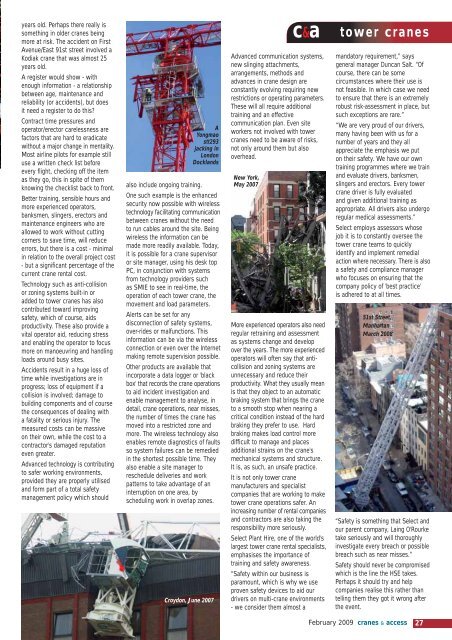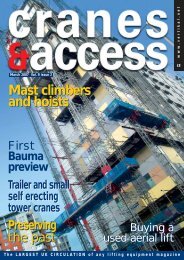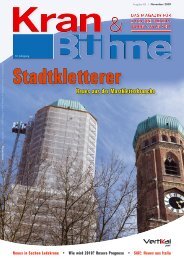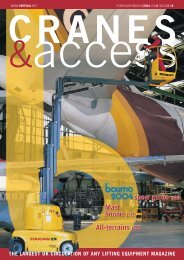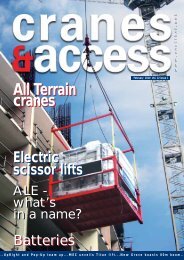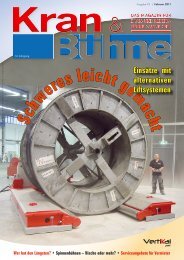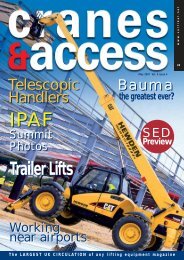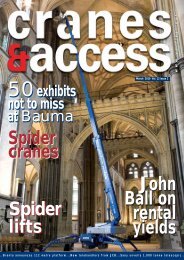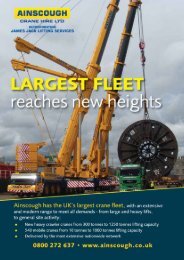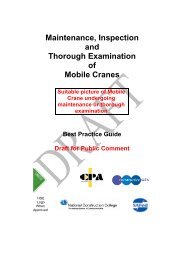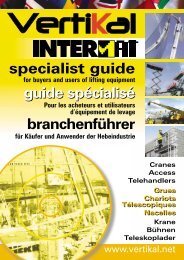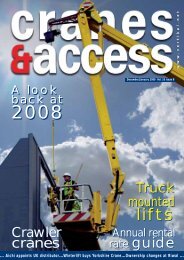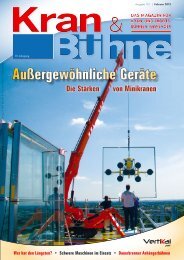You also want an ePaper? Increase the reach of your titles
YUMPU automatically turns print PDFs into web optimized ePapers that Google loves.
years old. Perhaps there really is<br />
something in older <strong>cranes</strong> being<br />
more at risk. The accident on First<br />
Avenue/East 91st street involved a<br />
Kodiak crane that was almost 25<br />
years old.<br />
A register would show - with<br />
enough information - a relationship<br />
between age, maintenance and<br />
reliability (or accidents), but does<br />
it need a register to do this?<br />
Contract time pressures and<br />
operator/erector carelessness are<br />
factors that are hard to eradicate<br />
without a major change in mentality.<br />
Most airline pilots for example still<br />
use a written check list before<br />
every flight, checking off the item<br />
as they go, this in spite of them<br />
knowing the checklist back to front.<br />
Better training, sensible hours and<br />
more experienced operators,<br />
banksmen, slingers, erectors and<br />
maintenance engineers who are<br />
allowed to work without cutting<br />
corners to save time, will reduce<br />
errors, but there is a cost - minimal<br />
in relation to the overall project cost<br />
- but a significant percentage of the<br />
current crane rental cost.<br />
Technology such as anti-collision<br />
or zoning systems built-in or<br />
added to tower <strong>cranes</strong> has also<br />
contributed toward improving<br />
safety, which of course, aids<br />
productivity. These also provide a<br />
vital operator aid, reducing stress<br />
and enabling the operator to focus<br />
more on manoeuvring and handling<br />
loads around busy sites.<br />
Accidents result in a huge loss of<br />
time while investigations are in<br />
progress; loss of equipment if a<br />
collision is involved; damage to<br />
building components and of course<br />
the consequences of dealing with<br />
a fatality or serious injury. The<br />
measured costs can be massive<br />
on their own, while the cost to a<br />
contractor's damaged reputation<br />
even greater.<br />
Advanced technology is contributing<br />
to safer working environments,<br />
provided they are properly utilised<br />
and form part of a total safety<br />
management policy which should<br />
A<br />
Yongmao<br />
stt293<br />
jacking in<br />
London<br />
Docklands<br />
also include ongoing training.<br />
One such example is the enhanced<br />
security now possible with wireless<br />
technology facilitating communication<br />
between <strong>cranes</strong> without the need<br />
to run cables around the site. Being<br />
wireless the information can be<br />
made more readily available. Today,<br />
it is possible for a crane supervisor<br />
or site manager, using his desk top<br />
PC, in conjunction with systems<br />
from technology providers such<br />
as SMIE to see in real-time, the<br />
operation of each tower crane, the<br />
movement and load parameters.<br />
Alerts can be set for any<br />
disconnection of safety systems,<br />
over-rides or malfunctions. This<br />
information can be via the wireless<br />
connection or even over the Internet<br />
making remote supervision possible.<br />
Other products are available that<br />
incorporate a data logger or 'black<br />
box' that records the crane operations<br />
to aid incident investigation and<br />
enable management to analyse, in<br />
detail, crane operations, near misses,<br />
the number of times the crane has<br />
moved into a restricted zone and<br />
more. The wireless technology also<br />
enables remote diagnostics of faults<br />
so system failures can be remedied<br />
in the shortest possible time. They<br />
also enable a site manager to<br />
reschedule deliveries and work<br />
patterns to take advantage of an<br />
interruption on one area, by<br />
scheduling work in overlap zones.<br />
Croydon, June 2007<br />
c&a<br />
Advanced communication systems,<br />
new slinging attachments,<br />
arrangements, methods and<br />
advances in crane design are<br />
constantly evolving requiring new<br />
restrictions or operating parameters.<br />
These will all require additional<br />
training and an effective<br />
communication plan. Even site<br />
workers not involved with tower<br />
<strong>cranes</strong> need to be aware of risks,<br />
not only around them but also<br />
overhead.<br />
New York,<br />
May 2007<br />
More experienced operators also need<br />
regular retraining and assessment<br />
as systems change and develop<br />
over the years. The more experienced<br />
operators will often say that anticollision<br />
and zoning systems are<br />
unnecessary and reduce their<br />
productivity. What they usually mean<br />
is that they object to an automatic<br />
braking system that brings the crane<br />
to a smooth stop when nearing a<br />
critical condition instead of the hard<br />
braking they prefer to use. Hard<br />
braking makes load control more<br />
difficult to manage and places<br />
additional strains on the crane's<br />
mechanical systems and structure.<br />
It is, as such, an unsafe practice.<br />
It is not only tower crane<br />
manufacturers and specialist<br />
companies that are working to make<br />
tower crane operations safer. An<br />
increasing number of rental companies<br />
and contractors are also taking the<br />
responsibility more seriously.<br />
Select Plant Hire, one of the world's<br />
largest tower crane rental specialists,<br />
emphasises the importance of<br />
training and safety awareness.<br />
“Safety within our business is<br />
paramount, which is why we use<br />
proven safety devices to aid our<br />
drivers on multi-crane environments<br />
- we consider them almost a<br />
tower <strong>cranes</strong><br />
mandatory requirement,” says<br />
general manager Duncan Salt. “Of<br />
course, there can be some<br />
circumstances where their use is<br />
not feasible. In which case we need<br />
to ensure that there is an extremely<br />
robust risk-assessment in place, but<br />
such exceptions are rare.”<br />
“We are very proud of our drivers,<br />
many having been with us for a<br />
number of years and they all<br />
appreciate the emphasis we put<br />
on their safety. We have our own<br />
training programmes where we train<br />
and evaluate drivers, banksmen,<br />
slingers and erectors. Every tower<br />
crane driver is fully evaluated<br />
and given additional training as<br />
appropriate. All drivers also undergo<br />
regular medical assessments.”<br />
Select employs assessors whose<br />
job it is to constantly oversee the<br />
tower crane teams to quickly<br />
identify and implement remedial<br />
action where necessary. There is also<br />
a safety and compliance manager<br />
who focuses on ensuring that the<br />
company policy of 'best practice'<br />
is adhered to at all times.<br />
51st Street,<br />
Manhattan<br />
March 2008<br />
“Safety is something that Select and<br />
our parent company, Laing O'Rourke<br />
take seriously and will thoroughly<br />
investigate every breach or possible<br />
breach such as near misses.”<br />
Safety should never be compromised<br />
which is the line the HSE takes.<br />
Perhaps it should try and help<br />
companies realise this rather than<br />
telling them they got it wrong after<br />
the event.<br />
February 2009 <strong>cranes</strong> & access 27


